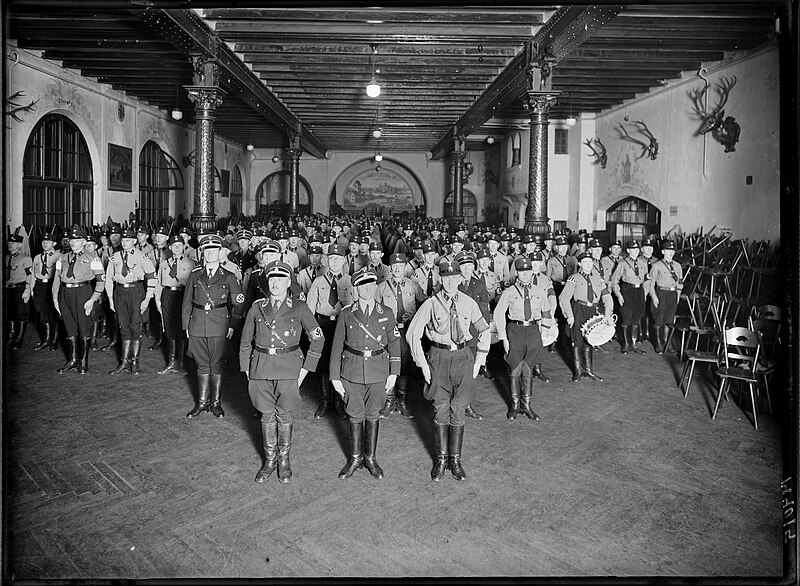File:SS Schutzstaffel at attention Group portrait Beer hall 1. SS-Standarte Munich Germany c. 1933 Nazi Party NSDAP paramilitary uniforms Propaganda US National Archives NARA Unrestricted use 242-HF-0093 001.jpg

Original file (4,780 × 3,500 pixels, file size: 2.29 MB, MIME type: image/jpeg)
Captions
Captions
Summary[edit]
| DescriptionSS Schutzstaffel at attention Group portrait Beer hall 1. SS-Standarte Munich Germany c. 1933 Nazi Party NSDAP paramilitary uniforms Propaganda US National Archives NARA Unrestricted use 242-HF-0093 001.jpg |
English: Schutzstaffel at attention
Photo copied from the US National Archives and Records Administration collection of material seized as American enemy property in Germany after World War II in 1945; "Miscellaneous Photographs, ca. 1919–ca. 1934" includes diverse subjects such as Hitler's grade school class, portraits of Hitler and NSDAP members, group photographs of SA and SS men, and architectural photos of significant buildings. NARA: Unrestricted access and use. These photographs held by the National Archives are in the public domain. |
| Date |
circa 1932 date QS:P,+1932-00-00T00:00:00Z/9,P1480,Q5727902 |
| Source | https://catalog.archives.gov/id/162121405 (National Archives Catalog, National Archives and Records Administration, U.S.A.) |
| Author | Uncredited author. NARA (US National Archives and Records Administration): Unrestricted access and use. |
Licensing[edit]
- You are free:
- to share – to copy, distribute and transmit the work
- to remix – to adapt the work
- Under the following conditions:
- attribution – You must give appropriate credit, provide a link to the license, and indicate if changes were made. You may do so in any reasonable manner, but not in any way that suggests the licensor endorses you or your use.
- share alike – If you remix, transform, or build upon the material, you must distribute your contributions under the same or compatible license as the original.
| Public domainPublic domainfalsefalse |
|
This work is in the public domain in its country of origin and other countries and areas where the copyright term is the author's life plus 70 years or fewer.
| |
| This file has been identified as being free of known restrictions under copyright law, including all related and neighboring rights. | |
https://creativecommons.org/publicdomain/mark/1.0/PDMCreative Commons Public Domain Mark 1.0falsefalse

|
This file was provided to Wikimedia Commons by the National Archives and Records Administration as part of a cooperation project. The National Archives and Records Administration provides images depicting American and global history which are public domain or licensed under a free license.
العربية ∙ български ∙ Deutsch ∙ English ∙ Esperanto ∙ español ∙ français ∙ Ido ∙ 日本語 ∙ 한국어 ∙ македонски ∙ മലയാളം ∙ Nederlands ∙ português ∙ русский ∙ Türkçe ∙ українська ∙ 简体中文 ∙ 繁體中文 ∙ 正體中文(臺灣) ∙ +/− |
| Public domainPublic domainfalsefalse |
This work is in the public domain in the United States because it is a work prepared by an officer or employee of the United States Government as part of that person’s official duties under the terms of Title 17, Chapter 1, Section 105 of the US Code.
Note: This only applies to original works of the Federal Government and not to the work of any individual U.S. state, territory, commonwealth, county, municipality, or any other subdivision. This template also does not apply to postage stamp designs published by the United States Postal Service since 1978. (See § 313.6(C)(1) of Compendium of U.S. Copyright Office Practices). It also does not apply to certain US coins; see The US Mint Terms of Use.
|
 | |
| This file has been identified as being free of known restrictions under copyright law, including all related and neighboring rights. | ||
https://creativecommons.org/publicdomain/mark/1.0/PDMCreative Commons Public Domain Mark 1.0falsefalse

|
Legal disclaimer This image shows (or resembles) a symbol that was used by the National Socialist (NSDAP/Nazi) government of Germany or an organization closely associated to it, or another party which has been banned by the Federal Constitutional Court of Germany. The use of insignia of organizations that have been banned in Germany (like the Nazi swastika or the arrow cross) may also be illegal in Austria, Hungary, Poland, Czech Republic, France, Brazil, Israel, Ukraine, Russia and other countries, depending on context. In Germany, the applicable law is paragraph 86a of the criminal code (StGB), in Poland – Art. 256 of the criminal code (Dz.U. 1997 nr 88 poz. 553). |
File history
Click on a date/time to view the file as it appeared at that time.
| Date/Time | Thumbnail | Dimensions | User | Comment | |
|---|---|---|---|---|---|
| current | 23:24, 17 June 2023 |  | 4,780 × 3,500 (2.29 MB) | Wolfmann (talk | contribs) | Uploaded a work by Uncredited author. NARA (US National Archives and Records Administration): Unrestricted access and use. from https://catalog.archives.gov/id/162121405 (National Archives Catalog, National Archives and Records Administration, U.S.A.) with UploadWizard |
You cannot overwrite this file.
File usage on Commons
There are no pages that use this file.
- CC-BY-SA-4.0
- CC-PD-Mark
- Author died more than 70 years ago public domain images
- Media contributed by the National Archives and Records Administration
- PD US Government
- Nazi symbols status
- Images from the National Archives and Records Administration
- US National Archives series: Miscellaneous Photographs, ca. 1919 - ca. 1934